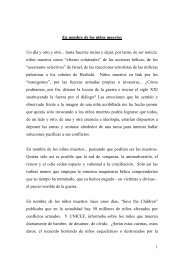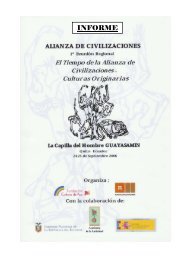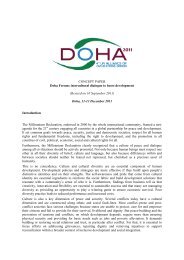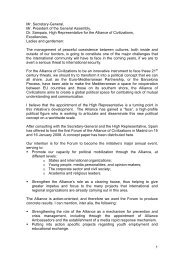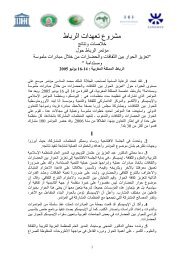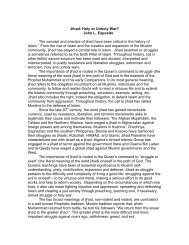detailed information about the 4th UNAOC Summer School
detailed information about the 4th UNAOC Summer School
detailed information about the 4th UNAOC Summer School
You also want an ePaper? Increase the reach of your titles
YUMPU automatically turns print PDFs into web optimized ePapers that Google loves.
<strong>the</strong> site previously occupied by <strong>the</strong> former Royal Opera House in <strong>the</strong> heart of <strong>the</strong> city, a<br />
wound that has left Malta’s MPs divided <strong>the</strong>se past 60 years over what should replace it.<br />
During <strong>the</strong> post-war years, Valletta lost many of its citizens who moved out to more<br />
modern houses in o<strong>the</strong>r localities and its population dwindled to 9,000 inhabitants.<br />
However, in <strong>the</strong> last few years many individuals with a flair for unique architecture are<br />
trickling back into <strong>the</strong> city and investing in old properties.<br />
Valletta, <strong>the</strong> smallest capital of <strong>the</strong> European Union, is now <strong>the</strong> island’s major<br />
commercial and financial centre and is visited daily by throngs of tourists eager to<br />
experience <strong>the</strong> city’s rich history.<br />
MDINA<br />
(From wikipaedia)<br />
Mdina, Città Vecchia, or Città Notabile, (English: Notabile, or Imdina; Phoenician:<br />
, Melitta) [1] is <strong>the</strong> old capital of Malta. Mdina is a medieval walled town situated<br />
on a hill in <strong>the</strong> centre of <strong>the</strong> island. Punic remains uncovered beyond <strong>the</strong> city’s walls<br />
suggest <strong>the</strong> importance of <strong>the</strong> general region to Malta’sPhoenician settlers. Mdina is<br />
commonly called <strong>the</strong> "Silent City" by natives and visitors. [2] The town is still confined<br />
within its walls, and has a population of just over three hundred, [3] but it is contiguous<br />
with <strong>the</strong> village of Rabat, which takes its name from <strong>the</strong> Arabic word for suburb, and has<br />
a population of over 11,000.<br />
History<br />
Mdina was inhabited and possibly first fortified by <strong>the</strong> Phoenicians around 700 BC. The<br />
Phoenicians called it Maleth. [4] The region benefits from its strategic location on one of<br />
<strong>the</strong> island's highest points and at maximum distance from <strong>the</strong> sea. Under <strong>the</strong> Roman<br />
Empire Malta became a Municipium and <strong>the</strong> Roman Governor built his palace in Mdina.<br />
Tradition holds that <strong>the</strong> Apostle St. Paul resided in <strong>the</strong> city after his historical shipwreck<br />
on <strong>the</strong> islands.<br />
An Aerial view of Mdina and its walls in 2007<br />
The name and <strong>the</strong> layout of <strong>the</strong> city reflect <strong>the</strong> Fatimid Period which began in 870 AD<br />
and lasted until <strong>the</strong> Norman conquest of Malta in 1091 AD. The earliest surviving<br />
buildings date from <strong>the</strong> Norman period. The Normans surrounded <strong>the</strong> city with thick<br />
47





